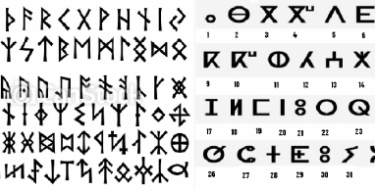As described in the article titled “Text of the Pyramids: “It came flames out of the island on the day of the great flood”“. This is an example of some of the many similarities between the religions of the Pharaohs, the Mayans, and the Vikings.
The descendants of the Vikings has pretended not to see the article. Except a small comment on facebook which claimed that there is a study on the genetics which shows a link of kinship between the Berbers and the Sami.
Negative propaganda towards North Africans led by their school, their media, and their intellectuals makes them prefer to have an Asian descent rather than to share their past with North Africans.
In rigor, they agree that North Africans can share a gene with the Sami people; a people of pastors, no sailors, it must be reminded. This is a way of insinuating that Samis are foreigners in Scandinavia. But explain how the Sami people can have a gene in common with North Africans, which should be impossible.
I have doubts that there is a common gene for all North Africans. A common story, yes, but a common gene is doubtful when we know the variety of people who have settled in this part of the continent.
On the other hand, with contacts between marine people, we can establish their possibilities as explained by the study by the American researcher, Sternberg, Joseph, on the origin of the first alphabets.
Joseph Sternberg
The language used by the ancient Berbers, as well as the origin of their alphabet, are unknown leaving un-read a large and increasing number of inscriptions across North Africa. The objective of this paper is to pro-vide the rationale for a new attempt to translate the Libyco-Berber part of the bilingual Dougga monument , this time trying a Proto-European language instead of known Berber languages. Three decades ago an alphabet, virtually the same as the Tifinagh alphabet in use today by the Tuaregs in North Africa, was found on a large limestone rock in Canada which also contained Algonquin petroglyphs. The representations of various figures from Nordic mythology, and other aspects of the inscriptions, indicated that they were made by Scandinavians during the Scandinavian Bronze Age and that not only the shapes but also the sound values of the alphabets in Peterborough and North Africa were largely the same. This epigraphic work has apparently been ignored. Published research, together with writings from classical sources, offers plausible motives for a Scandinavian visit to Canada, the feasibility of such a visit, as well as the suggestion that the Tifinagh alphabet was introduced by the Berbers into North Africa at the time of the attacks on Egypt by the “peoples from the sea”. This would imply that the ancient language used by the Berbers was a Proto-European language.
1. THE PROBLEM
The Berbers of North Africa, from hundreds of years BC to 300 AD, leftover 1200 rock inscriptions (Camps 1996) written in their own alphabet, the Libyan alphabet, a consonantal alphabet, with two versions, the Tifinagh and the Libyco-Berber. The Libyco-Berber alphabet replaces patterns of dots by patterns of bars to represent seven letters in Tifinagh.
The source of this alphabet has been investigated for over 100 years without any resolution (Chaker & Hachi, 2000), (Galand, 2001). Apparent links to the Phoenician-Punic alphabets are very limited. According to Chaker & Hachi, it is certain or probable that four letters of the Tifinagh alphabet can be identified with the letters of the Phoenician-Punic alphabet, letters that have similar shapes and sound values. As the say, the great majority of the Libyan letters appear ex nihilo not showing any connection with the Phoenician-Punic alphabets. No inscriptions have been found that indicate a transition of these letters from the Phoenician-Punic to the Libyan. This has led to the belief that, aside from a small number of borrowings, the Libyan alphabet was, for the most part, created in Africa. But, apparently, no one has yet provided the evidence for such a development.
Furthermore the language used by the ancient Berbers remains unknown. Attempts to translate the Libyco-Berber part of the Dougga bilingual inscription (Punic and Libyco-Berber), using known Berber languages, have not been successful.. As will be discussed in what follows, a discovery made in North America over 30 years ago, which has been overlooked, identified Scandinavia as the source of the Tifinagh alphabet, and further showed that the Tifinagh dot forms for 7 letters are original and that the bar forms for these letters in Libyco-Berber are substitutions.
2. NORTH AMERICA
In 1954, a large limestone rock covered with petroglyphs was found by geologists in the wilderness in Canada, in the course of doing fieldwork. It was concluded that the petroglyphs dated back to the prehistoric occupation of the area by the Algoquian Indians since none of the current Indian tribes had any knowledge of the inscriptions. A Petroglyph Provincial Park was constructed near Peterborough, Canada to house this exceptional find. Peterborough is at the most southern end of Canada’s Ontario Province just north of Lake Ontario.
In 1982, Barry Fell published a book “Bronze Age America” in which he claimed to have discovered an alphabet on the rock (which he named Proto-Tifinagh) that was readily identifiable with the Tifinagh alphabet in North Africa and which he claimed was put there by Scandinavian visitors during the Scandinavian Bronze Age. Fell had been Professor of Invertebrate Zoology at Harvard University until his retirement in 1979. His life long interest in ancient scripts and languages was pursued full time after his retirement from Harvard. He became a very controversial figure among archaeologists because of his many claims of the identification of languages and decipherments of rock inscriptions found throughout North and South America.
Fell’s critics largely consisted of prominent archaeologists, not epigraphers, who emphasized the lack of “dirt” archaeology supporting the presence of visitors in the areas of the inscriptions. By the time of the publication of the Bronze Age book archaeologists had written him off and apparently nothing was published about Fell’s epigraphic analysis at Peterborough. It was just ignored until David Kelley, Professor of Archaeology at Calgary University, decided to take the time to look into a large body of Fell’s epigraphic work, not just the Peterborough inscriptions. Kelley was an archaeologist and epigrapher of considerable reputation and was widely published. He was particularly noted for making important contributions to the decipherment of the Mayan script. The result of Kelley’s investigation, which included personally visiting many sites, was published in the Review of Archaeology (Kelley,1990).
Kelley was critical about a number of aspects of Fell’s work but he was highly complimentary about Fell’s recognition of the presence of a Proto-Tifinagh script at Peterborough. As noted by Kelley, most of the letters in the Peterborough inscriptions show virtual identity in shape and sound value with Tifinagh in North Africa. The letters at Peterborough are spread around various representations, specifically including a number of figures readily recognized and named from Scandinavian mythology. Together with other features of the inscriptions at Peterborough, Kelley agreed with the conclusion that the in-scriptions were Scandinavian and were being used to write an ancient Nordic language. According to Kelley, the conclusion about the identity of the alphabet as Proto-Tifinagh was “certain”, not “possibly” or “could be”.
When could these inscriptions have been made given that the dating of rock inscriptions is often problematic? But in this case a crude Zodiac was found among the inscriptions on the rock. Based on the known time for the precession of the equinoxes, the time of the inscriptions was estimated to have been during the Scandinavian Bronze Age which lasted from 1800-500 BC. Kelley continued to work on the problem and published a paper in a book Across Before Columbus (Kelley,1998) providing a de-tailed account of the epigraphic analyses of the Peterborough inscriptions, including his own contri-butions and the analysis of some possible phonic and symbol differences from North African Tifinagh. The book was derived from a Symposium held at Brown University in 1992. The scholars concerned with North African inscriptions may not have been aware of Kelley’s paper considering where it was published.
In any case, no comments on the paper have apparently been published. Kelley died a few years ago. As detailed in Kelley’s 1998 paper, the same alphabet is found on Bronze Age inscriptions in Bohuslan, Sweden. This challenges the belief that writing only started in Scandinavia with the appearance of the runic alphabet in the Iron Age. Kelley notes that he himself would have not recognized the presence of an alphabet if it had not been pointed out by Fell. Thus it is not surprising that the presence of an alphabet on Scandinavian Bronze Age inscriptions, where seven letters were represented by patterns of dots, was not recognized by Scandinavian archaeologists. So the inscribers at Peterborough were not Berbers from North Africa. Yet somehow the ancient Berbers were using a similar alphabet. What were these Scandinavians doing at this inland site in North America and how did they get there? And how did ancient Tifinagh get to North Africa since the Proto-Tifinagh script was Scandinavian? Good questions.
3. A SCANDINAVIAN MISSION
What sense could be made of the motivation and feasibility of a Scandinavian visit to the Peterborough area? Fell had proposed, on the basis of some of the inscriptions that the Scandinavians were there to obtain copper during the Bronze Age in Northern Europe. There are an estimated 5,000 mining pits in the area at the north end of Lake Superior, particuarly on Isle Royale. While an average pit was perhaps 20 feet in diameter and 30 feet deep, some were over 50 feet deep and had excavated trenches 100 feet in width. Prof Roy Drier of the Michigan College of Mining and Technology, who led a team to explore the mines in 1953, estimated that as much as 500,000,000 pounds of copper were mined in prehistoric times.
As in only a few other places in the world, the mines in this area contain native copper so no smelting was necessary and the copper could be worked to the desired shapes. Since the ancient miners worked with stone malls, an immense effort was required for extraction of the copper, which suggests that they weren’t mining for trinkets, but rather for tools, armaments, and trade. Archaeological excavations in North America have so far not turned up such large quantities of copper so it would seem that much of the missing metal may have been shipped elsewhere. Evidence at the mines indicated that a method used for extracting the copper was to build a fire on the rock strata to heat the rock and then pour water on the fire, fracturing the rock and permitting the extraction of the copper. Samples of charcoal taken from the bottom of the pits were used for carbon dating indicating that the pits continued to be worked for thousands of years and were in use during the Scandinavian Bronze Age. A book covering this work was self-published (Drier & DuTemple 1961).
In 2005, a soft cover edition was published. It would not have been possible for the Scandinavians to sail a ship from the Gulf of St. Lawrence to the mines at the north end of Lake Superior. But it would have been possible to sail up the St. Lawrence to Lake Ontario. Archaeologists have found evidence of ancient trading routes along the waterways connecting the mines to the East.
So the copper for the Scandinavians could have been moved from the mines to Lake Ontario. There is another reason to suggest that the Scandinavian ship was sailed to Lake Ontario. The large limestone rock at Peterborough ( 55 meters long and 30 meters wide) is close to Lake Ontario and could have been plausibly discovered by the Scandinavian visitors. The Algonkian petroglyphs are believed to date from 900 -1400 AD. If that dating is correct, the rock would have been free of engravings when found by the visitors. And it would have been a convenient place for the Scandinavians to put their inscriptions on the rock. Still, North America was a long way to go for copper. Some light on this question has been obtained in a current research project at the Department of Historical Studies, University of Gothenburg, Sweden.
The subject of the study is “Extraction of copper in Sweden during the Bronze Age”. The first question was whether copper was imported to Scandinavia or mined locally during the Scandinavian Bronze Age. Lead isotope and chemical analyses were carried out on 33 bronze items that had been dated between 1600 BC and 700 BC. A comparison of the composition of the bronze artifacts with the composition of ores from old Scandinavia mines indicated that the copper in the bronze artifacts must have been imported from elsewhere. (Ling et al, 2013) It was also noted that the artifact data tended to form different groups depending on their chronology. As determined in a second report (Ling et al, 2014), including 38 additional Swedish artifacts, sources for artifacts were identified in Europe and the Mediterranean area. On the basis of their findings, they hypothesized that there were two major systems of metal flow from Europe to Sweden in the Bronze Age; one Atlantic and one via Central and southeast Europe.
The Atlantic network provided Scandinavia with ingots of copper and tin while the Central European systems, following in general the Amber Roads, delivered both finished artifacts and ingots of metals. They also suggested that Baltic amber provides the most concrete evidence of a Scandinavian “commodity” traded for copper-based on the findings of Baltic amber in ore-bearing districts with isotopes consistent with Scandinavian artifacts. It seems clear that copper was imported to Scandinavia from distant sources. There is classical evidence that some of the ancient Carthaginians knew about and used a route across the North Atlantic past Iceland and Greenland to the Gulf of St. Lawrence. An account of ancient voyages to the New World is given by Plutarch, (Morals, Vol.V, 281-284, 1878 Harvard translation) including references to astronomical phenomena, the position of the sun and planets, and statements of courses and distances couched in general language. According to Plutarch, this account was contained in a manuscript that had been found (not by him) buried in the ruins of Carthage.
At an 1893 meeting of the New York Albany Institute of History and Art, celebrating 400 years since the voyage of Columbus, Verplanck Colvin, then President of the Institute, presented a detailed analysis of the account provided by Plutarch. Colvin was a man of many talents (lawyer, American wilderness surveyor) and a member of numerous scientific societies who had given lectures at Hamilton College on geodesy, surveying, and topographical engineering. In 1898 his paper, which included a copy of Plutarch’s account, was published (Colvin, 1898). This book is currently available on the web at the US Library of Congress. Colvin concluded that the information provided by Plutarch clearly described a northern route going by Iceland and Greenland to the Gulf of St. Lawrence. It is plausible that the Scandinavians would have known and used this route, if it were known and used by some Carthaginians. The northern route from Scandinavia to Canada closed down during the “little ice age” (which was a cold period between 1550 and 1850 AD) leading to the demise of the Greenland settlements. But the paleoclimatology records indicate that the Nordic Bronze Age was characterized by a relatively warm climate that began with a climate change around 2700 BC to a climate comparable to that of present day Central Germany and Northern France. A wetter colder climate prevailed after a minor change in climate between 850 BC and 760 BC, and a more radical one around 650 BC. So a voyage across the North Atlantic would have been feasible during the Scandinavian Bronze Age.
4. THE ALPHABET AND LANGUAGE OF THE ANCIENT BERBERS
We are still left with the question as to how the Tifinagh alphabet could have found its way to North Africa. There is some evidence of the presence of the Proto-Tifinagh alphabet in southern Europe. Valcarmonica, a World Heritage Site, located on the Italian Lombardy plain, has one of the world’s greatest collections of prehistoric petroglyphs. More than 140,000 symbols and figures have been carved over the rocks over a period of 8,000 years. Kelley notes in his 1998 paper that a quick examination of a book containing these engravings “shows the presence of at least eighteen of the Proto-Tifinagh letters”. It is not known when or by whom these letters were engraved in the rocks but the site is not far from the Amber Road used for millennia connecting northern Europe with the Mediterranean.
In 1984, Dr. Cheikh Anta Diop presented a paper at a UNESCO symposium in Paris (Diop, 1984) in which he stated his opinion that the Berbers living in North Africa and the Sahara are direct descendants of some of the peoples who attacked Egypt circa 1200 BC, referred to by the Egyptians as “peoples from the sea”. Diop was one of the most prominent and proficient African scholars (a university in Dakar is named after him) studying the history of African civilization. He was born in Senegal and received his post-graduate education in Paris. His discoveries had disclosed previously unrecognized accomplishments in the history of Africa. Yet he concluded from his studies that the Berbers did not originate in Africa. According to Diop, the people from the sea had been dislodged by from their respective territories in Southeastern Europe and Asia Minor. One consequence of the series of assaults on Egypt was that while the sea people were ultimately defeated, they didn’t just go home. The Philistines, who had been captured by the Egyptians, were settled by Ramses III in Palestine and, according to Diop, many tribes of the sea peoples (including the Berbers) were settled to the west of Egypt. Support for the possibility that a component of the Sea Peoples came from Southeastern Europe (by way of the Black Sea), is discussed by Shelley Wachsmann, (Professor of Marine Archaeology at Texas A&M University), in a book (Wachsmann, 1998). The ships used by the Sea Peoples in the naval battle of 1176 BC are depicted in a relief on the outer wall of Ramses III’s mortuary temple at Medinet Habu. The special features of these ships are “curving hulls ending in perpendicular posts capped with bird-head devices facing outboard”. Wachsman noted that similar “bird boats” dated to 1250-1200 BC have been found in northern Rumania, Hungary and Bavaria.
5. CONCLUDING REMARKS
So where does this leave us? First of all there is the general belief that a small number of letters of the Tifinagh alphabet were borrowed from the Phoenician-Punic alphabet. Chaker & Hachi considered four letters to be certain or probable in their similarity of shape and sound value to the ancient Semitic alphabets, g, z, s, and t . But all of these letters are present in the Proto-Tifinagh inscriptions at Peterborough. So if they had been borrowed from the Phoenician-Punic alphabet the Scandinavians not the Berbers would have done the borrowing. Another point noted by many authors is the fact the geometric forms of the libyco-berber alphabet contrast with the cursive form of the punic alphabet. Chaker & Hachi note that it is difficult to imagine that the geometric forms evolved from rounded forms (while the inverse evolution is frequently at-tested.). Perhaps it was the Phoenicians who bor-rowed from the Proto-Tifinagh alphabet. There are over a thousand unread Libyan inscriptions (many of them short) in North Africa and more continue to be found. Recently a major project was undertaken with the support of the British Library to record the Libyan inscriptions in Tifinagh characters in the Acacus mountains in Libya (Biagetti et al 2012). As has been discussed, there are clues as to how the Proto-Tifinagh alphabet reached North Africa in the hands of the Berbers but that is not evidence that the Berbers were necessarily Scandinavians or were using the alphabet to write a Nordic language. People other than the Scandinavians could have been using the Proto-Tifinagh alphabet. But it does imply that the language of the ancient Berbers was a Proto-European language. This suggests a new attempt at translating the Libyco-Berber writing on the Dougga bilingual monument where previous attempts have been limited to the many known Berber languages.
REFERENCES Biagetti, S. ,Kaci, A.A., Mori, L., di Lernia, S. (2012) Writing the desert: the Tifinagh rock inscriptions of the Tadart Acacus (southwestern Libya) Azania: Archaeological Research in Africa, 47, No. 2, June: 153-74. Camps, G. ( 1996) Écriture Libyque. Encyclopédie berbère 17: 2564-73. Chaker, S. et Hachi, S. (2000) À propos de l’origine et de l’âge de l’écriture libyco- berbère. Reflexions du lin-guiste et du prehistorian. Etudes berberes et chamito-semetiques 93-111, Karl-G Prasse, Paris Colvin, V. 1898) Geographical and mathematical discussion of Plutarch’s account of ancient Voyages to the New World. YA Pamphlet Collection (Library of Congress) DLC. At Library of Congress Online Cata-logue, search Verplanck Colvin, check box 3, double Click the title of the paper to obtain PDF Link. Diop, C. A. (1984) Formation of the Berber branch, Libya Antiqua, UNESCO Symposium, Jan. 16-18, Paris, 69-73. Drier, R. and Du Temple, O. (1961) Michigan’s most ancient industry is America’s prehistoric copper mining. Prehistoric Copper Mining in the Lake Superior Region : 15-25. Calumet Michigan. Galand, L. (2001) Un vieux debat. L’origine de l’ecriture libyco-berbere”, La Lettre du RILB Repertoire des in-scriptions libyco-berberes 17, 1-3 Kelley, D. (1990) Proto-Tifinagh and Proto-Ogham in the Americas, The Review of Archaeology,, No. 1, 1-10 Kelley, D. (1998) The Identification of the Proto-Tifinagh Script at Peterborough, Ontario. Across Before Co-lumbus, The New England Antiquities Research Association, Edgecomb, Maine, 170-182 Ling, J, Hjarthner-Holdar, E.,Grandin, L., Billstrom, K., Persson, P. (2013) Moving metals or Indigenous min-ing? Provenancing Scandinavian Bronze Age artifacts by lead isotope and Trace elements. Journal of Archaeological Science 40 : 291-304. Ling, J., Stos-Gale, Z., Grandin, L., Billstrom, K., Hjarthner-Holdar, E., Persson, P. (2014) Moving Metals II: Prvenancing Scandinavian Bronze Age artifacts by lead isotope and Elemental analyses. Journal of Archaeological Science 41 : 106-132. Wachsman, S. (1998) The ships of the sea peoples. Seagoing Ships and Seamanship in the Bronze Age Levant 163-197, Texas A&M University Press, Chatham Publishing, London.
Sternberg, Joseph






Leave a Comment